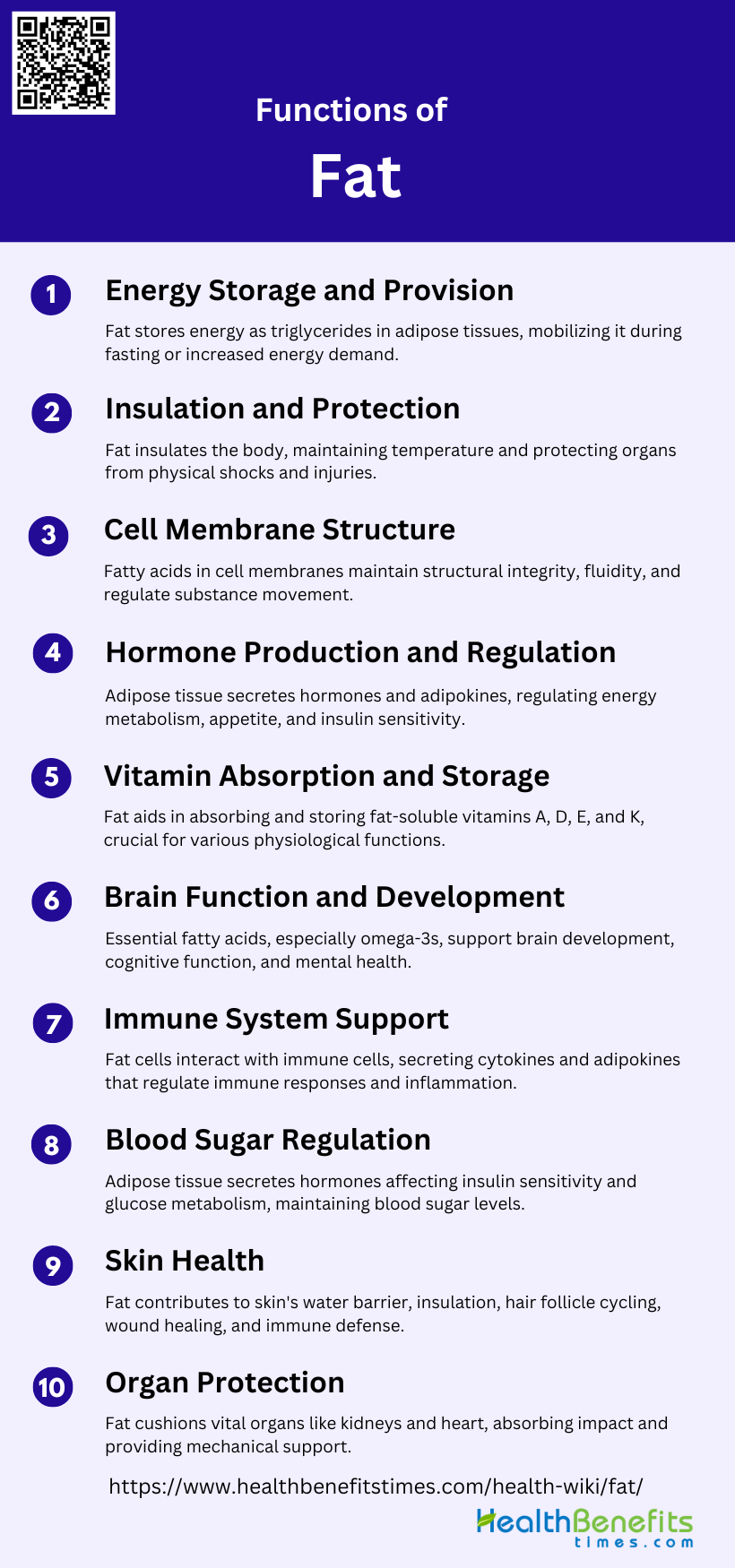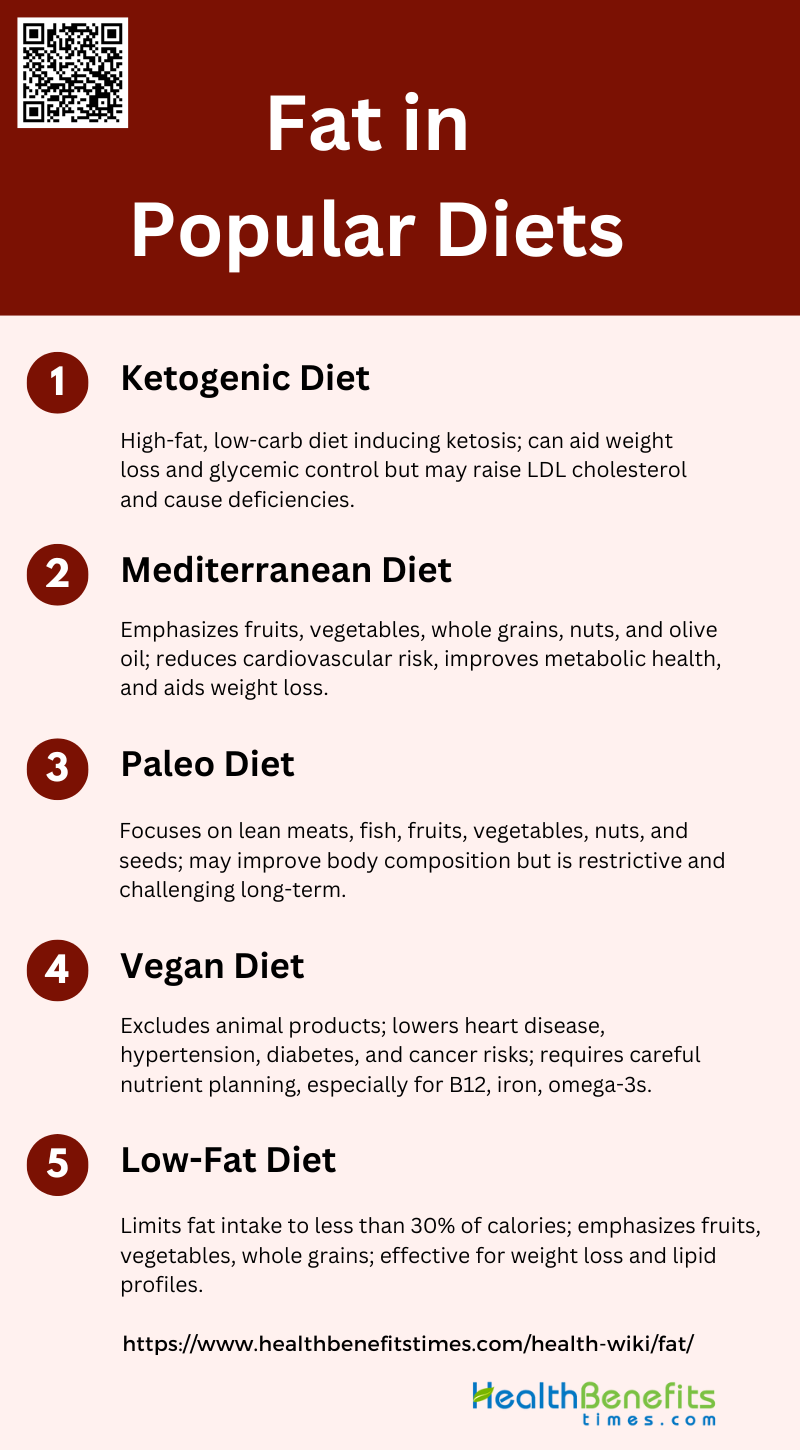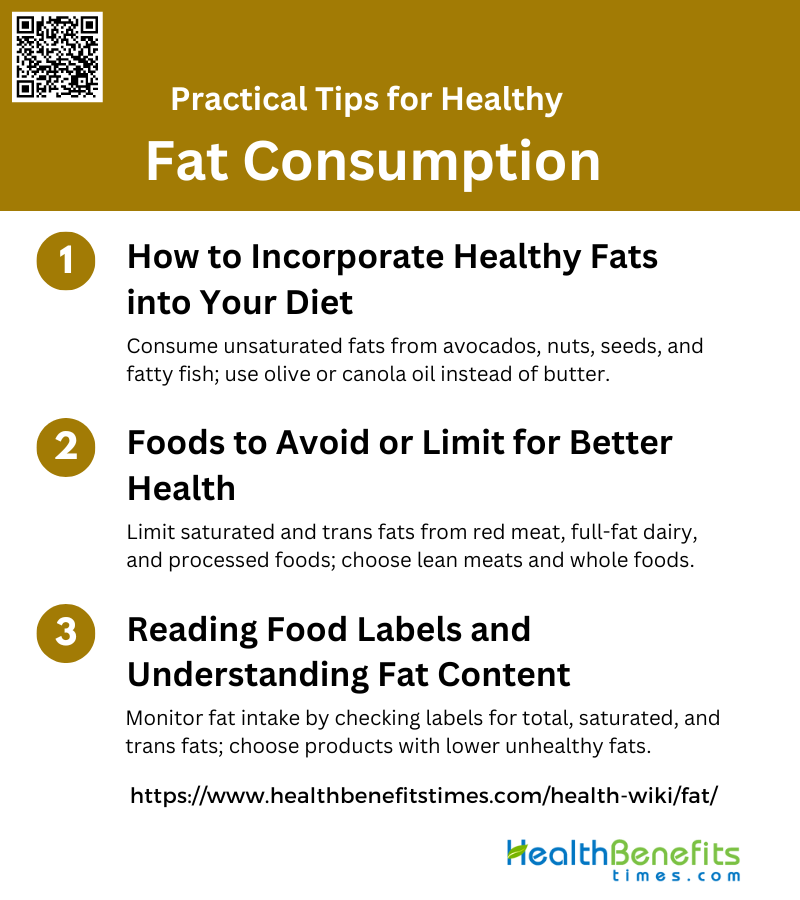Fat is a crucial component of the diet and biological systems, serving multiple roles. Chemically, fats are compounds of glycerol with fatty acids, which are long straight-chain carbon compounds. They are essential for energy storage, providing about twice the energy per gram compared to carbohydrates and proteins. Fats also play a significant role in the structure and function of body tissues, including the brain and nerves, and act as carriers for fat-soluble vitamins A, D, E, and K. In addition to their biological functions, fats contribute to the sensory qualities of food, such as flavor, texture, and aroma, making them a key component of palatability. The nutritional value of fats is influenced by their composition, which includes saturated, monounsaturated, and polyunsaturated fatty acids, each with distinct health implications.
Types of Fat
They can be broadly categorized into two main types, each serving distinct functions in the body. Below are the primary types of fat:
1. Dietary Fat
Dietary fat is a crucial component of a balanced diet, providing energy and aiding in the absorption of essential vitamins. Different types of dietary fats have varying effects on health, making it important to understand their sources and impacts. Here are the main types of dietary fats:
- Saturated Fats: Saturated fats are commonly found in animal products and are associated with increased serum cholesterol levels, leading to a higher risk of coronary heart disease and cardiovascular events. Reducing saturated fat intake can lower cardiovascular risk, especially when replaced with polyunsaturated fats.
- Monounsaturated Fats: Monounsaturated fats, primarily sourced from plant oils like olive oil, have a positive impact on serum lipid profiles and reduce LDL oxidation. They are associated with lower risks of cardiovascular disease and cancer when replacing saturated fats.
- Polyunsaturated Fats: Polyunsaturated fats, including omega-3 and omega-6 fatty acids, are beneficial for heart health and reduce the risk of type 2 diabetes and coronary heart disease. They are also linked to lower mortality rates from cardiovascular disease and cancer.
- Trans Fats: Trans fats, often found in hydrogenated oils, are associated with increased risks of coronary heart disease, type 2 diabetes, and higher mortality rates. Minimizing trans-fat intake is crucial for reducing cardiovascular and overall health risks.
2. Body Fat
Body fat is a crucial component of the human body, serving various functions such as energy storage, insulation, and protection of vital organs. It can be categorized into several types, each with distinct characteristics and roles in metabolism and health. Below are the types of Body Fats:
- White Fat: White fat acts primarily as an energy storage organ, storing excess energy in the form of triglycerides. It is the most abundant type of fat in the body and is found in both subcutaneous and visceral depots.
- Brown Fat: Brown fat is specialized in energy expenditure and heat production through a process known as nonshivering thermogenesis. It contains a high number of mitochondria and is metabolically active, playing a significant role in glucose and lipid metabolism.
- Beige Fat: Beige fat cells are found within white fat depots and can convert to a thermogenic state similar to brown fat in response to certain stimuli, such as cold exposure. They have a distinct gene expression profile and contribute to energy expenditure.
- Subcutaneous Fat: Subcutaneous fat is located beneath the skin and is considered more metabolically healthy compared to visceral fat. It has a higher potential for browning, which can improve systemic metabolic health.
- Visceral Fat: Visceral fat surrounds internal organs and is more metabolically active and inflammatory than subcutaneous fat. Its accumulation is associated with increased risk of metabolic diseases such as insulin resistance and cardiovascular disease.
- Essential Fat: Essential fat is necessary for normal physiological functions, including hormone regulation, immune function, and reproductive health. It is found in small amounts within various tissues and organs throughout the body.
Functions of Fat
Fat is an essential component of the human body, playing a variety of critical roles in maintaining health and well-being. From providing energy to supporting cell growth and hormone production, fat is indispensable. Below are the pr imary functions of fat:
1. Energy Storage and Provision
Fat serves as a primary energy reservoir in the body, storing energy in the form of triglycerides within adipose tissues. This stored energy can be mobilized during periods of fasting or increased energy demand, such as physical activity or stress. White adipose tissue (WAT) is particularly specialized for this function, storing excess energy and releasing it when needed. Additionally, brown adipose tissue (BAT) dissipates energy as heat, contributing to thermogenesis and energy expenditure. The efficient storage and release of energy by fat cells are crucial for maintaining energy homeostasis and supporting metabolic processes.
2. Insulation and Protection
Fat provides thermal insulation, helping to maintain body temperature by reducing heat loss. This is particularly important for animals in cold environments, where superficial fat layers act as insulators. Additionally, fat serves as a mechanical cushion, protecting internal organs and joints from physical shocks and injuries. The presence of fat around organs, such as the kidneys and heart, offers a protective layer that absorbs impact and reduces the risk of damage during physical activities or trauma.
3. Cell Membrane Structure
Fatty acids are essential components of cell membranes, contributing to their structural integrity and fluidity. Phospholipids, which are derived from fatty acids, form the bilayer structure of cell membranes, providing a barrier that regulates the movement of substances in and out of cells. The composition of fatty acids in cell membranes can influence membrane properties, such as permeability and flexibility, which are critical for proper cell function and signaling. This structural role of fats is fundamental to maintaining cellular homeostasis and supporting various physiological processes.
4. Hormone Production and Regulation
Adipose tissue functions as an endocrine organ, secreting various hormones and adipokines that regulate energy metabolism, appetite, and insulin sensitivity. Hormones such as leptin, adiponectin, and resistin are produced by fat cells and play significant roles in maintaining energy balance and metabolic health. Leptin, for example, regulates appetite and energy expenditure, while adiponectin enhances insulin sensitivity and has anti-inflammatory properties. These hormones and signaling molecules are crucial for coordinating metabolic processes and maintaining overall health.
5. Vitamin Absorption and Storage
Fat is essential for the absorption and storage of fat-soluble vitamins, including vitamins A, D, E, and K. These vitamins are absorbed in the intestines along with dietary fats and are stored in adipose tissues for future use. Fat-soluble vitamins play vital roles in various physiological functions, such as vision, bone health, antioxidant defense, and blood clotting. The presence of dietary fat enhances the bioavailability of these vitamins, ensuring that the body can utilize them effectively.
6. Brain Function and Development
Essential fatty acids, particularly omega-3 fatty acids, are crucial for brain development and function. These fatty acids are integral components of neuronal cell membranes and are involved in the formation of synapses and the transmission of nerve impulses. Omega-3 fatty acids, such as DHA, are important for cognitive function, memory, and overall mental health. Adequate intake of these essential fats supports brain development in infants and children and helps maintain cognitive function in adults.
7. Immune System Support
Fat cells interact with immune cells within adipose tissue, playing a role in immune system regulation. Adipose tissue secretes various cytokines and adipokines that influence immune responses and inflammation. For example, adiponectin has anti-inflammatory properties, while resistin is associated with increased inflammation and insulin resistance. The dynamic communication between fat cells and immune cells is essential for maintaining immune homeostasis and responding to infections and injuries.
8. Blood Sugar Regulation
Adipose tissue influences blood sugar regulation through the secretion of hormones and adipokines that affect insulin sensitivity and glucose metabolism. Adiponectin, for instance, enhances insulin sensitivity and helps regulate blood glucose levels. Conversely, increased levels of resistin are associated with insulin resistance and higher blood sugar levels. The balance of these signaling molecules is crucial for maintaining glucose homeostasis and preventing metabolic disorders such as type 2 diabetes.
9. Skin Health
Dermal white adipose tissue (dWAT) is involved in skin physiology, including hair follicle cycling and wound healing. dWAT cells secrete growth factors that support hair growth and skin repair, and they produce antimicrobial peptides that aid in the skin’s immune defense. The presence of fat in the skin helps maintain its integrity, hydration, and overall health.
10. Organ Protection
Fat provides a protective layer around vital organs, cushioning them against physical shocks and reducing the risk of injury. This protective function is particularly important for organs such as the kidneys, liver, and heart, which are surrounded by adipose tissue that absorbs impact and provides mechanical support. The presence of fat around these organs helps ensure their proper function and reduces the likelihood of damage during physical activities or trauma. This protective role of fat is essential for maintaining the health and stability of internal organs.
Healthy vs. Unhealthy Fats
Healthy Fats
Healthy fats, such as polyunsaturated and monounsaturated fatty acids, play a crucial role in maintaining overall health and preventing chronic diseases. Sources of these beneficial fats include plant oils like olive and canola oil, fatty fish, nuts, and seeds. Consuming these fats can lead to a reduction in serum and low-density lipoprotein (LDL) cholesterol levels, which are associated with a lower risk of cardiovascular diseases. Omega-3 fatty acids, a type of polyunsaturated fat found in fish and some vegetable oils, have been shown to reduce cardiovascular morbidity and mortality, and offer additional benefits such as improved cognitive function and reduced inflammation. Moreover, replacing saturated fats with unsaturated fats in the diet can improve lipid profiles and reduce the risk of type 2 diabetes and coronary heart disease. Despite the clear benefits, there remains confusion among consumers regarding the role of dietary fats, highlighting the need for effective communication and education on healthy dietary patterns.
Unhealthy Fats
Unhealthy fats particularly saturated and Trans Fats are associated with numerous health risks, including increased incidence of cardiovascular diseases, type 2 diabetes, and certain cancers. High-fat diets, especially those combined with carbohydrates, have been shown to be obesogenic and diabetogenic, leading to insulin resistance and higher cardiovascular risk. Foods high in saturated fats, such as meat and processed meat, are significantly associated with increased mortality risk, whereas dairy products like milk, cheese, and yogurt do not show a significant increase in mortality risk. Additionally, high intake of saturated fats has been linked to an increased risk of breast cancer and dementia. Unhealthy fats can also negatively impact gut microbiota, leading to adverse metabolic and inflammatory responses. Therefore, it is crucial to limit the intake of foods high in unhealthy fats, such as processed meats, certain dairy products, and foods high in added sugars, to mitigate these health risks.
Health Implications of Fats
Fats are an essential part of the human diet, but their impact on health varies significantly depending on the type of fat consumed. Here’s a detailed look at the health implications of different types of fats:
1. Saturated Fats
Saturated fats are typically found in animal products such as meat, butter, and cheese, as well as some plant oils like coconut and palm oil. High intake of saturated fats has been linked to increased levels of low-density lipoprotein (LDL) cholesterol, which can lead to a higher risk of cardiovascular diseases (CVD) such as heart disease and stroke. Therefore, it is generally recommended to limit the intake of saturated fats to reduce these health risks.
2. Unsaturated Fats
Unsaturated fats, which include monounsaturated and polyunsaturated fats, are found in foods like nuts, seeds, fish, and vegetable oils. These fats are considered beneficial for heart health as they can help reduce LDL cholesterol levels and increase high-density lipoprotein (HDL) cholesterol. Diets high in unsaturated fats have been associated with improved fertility and better overall health outcomes. Omega-3 and omega-6 fatty acids, types of polyunsaturated fats, are particularly important for reducing inflammation and supporting brain health.
3. Trans Fats
Trans Fats are artificially created through the hydrogenation of vegetable oils and are commonly found in processed foods, baked goods, and margarine. These fats are known to increase LDL cholesterol while decreasing HDL cholesterol, significantly raising the risk of coronary heart disease and other cardiovascular conditions. Due to their adverse health effects, many health organizations recommend minimizing or eliminating trans-fat intake.
3. Short-Chain, Medium-Chain, and Long-Chain Fatty Acids
The health effects of fats can also vary based on the length of their fatty acid chains. Short-chain fatty acids (SCFAs) are produced by the fermentation of dietary fiber in the gut and have been shown to have beneficial effects on gut health and metabolism. Medium-chain triglycerides (MCTs), found in coconut oil and dairy products, are more rapidly metabolized and may support weight loss and energy levels. Long-chain fatty acids (LCFAs), found in most dietary fats, have more complex metabolic effects and can be either beneficial or harmful depending on their saturation level.
4. Diet and Lifestyle Factors
The overall impact of dietary fats on health also depends on other lifestyle factors, including physical activity, overall diet quality, and genetic predispositions. For instance, urban populations with higher intake of animal proteins, saturated fats, and refined sugars tend to have higher rates of obesity, hypertension, and cardiovascular diseases compared to rural populations with more traditional diets.
Fat in Popular Diets
Fats are a fundamental component of many popular diets, each emphasizing different types and amounts to achieve various health goals. Understanding the role of fats in these diets can help you make informed nutritional choices. Here are some key points to consider:
1. Ketogenic Diet
The ketogenic diet (KD) has garnered significant attention for its potential benefits in treating obesity and type 2 diabetes. This high-fat, low-carbohydrate diet induces a state of ketosis, where the body burns fat for fuel instead of carbohydrates. Despite its popularity, evidence supporting its long-term efficacy and safety is limited. Studies have shown that while KD can lead to modest weight loss and improved glycemic control, these benefits are often not significantly greater than those achieved with other diets, such as low-fat diets. Additionally, KD may increase low-density lipoprotein (LDL) cholesterol levels, posing potential cardiovascular risks. Adverse effects, including gastrointestinal disturbances and nutrient deficiencies, further complicate its use.
2. Mediterranean Diet
The Mediterranean diet (MD) is renowned for its health benefits, particularly in reducing cardiovascular disease risk. This diet emphasizes the consumption of fruits, vegetables, whole grains, nuts, and olive oil, with moderate intake of fish and poultry, and limited red meat and dairy. Studies have shown that MD is effective in promoting weight loss and improving body composition, often outperforming very low-calorie ketogenic diets (VLCKD) in terms of fat mass reduction and preservation of fat-free mass. Additionally, MD has been associated with improved metabolic health, including better lipid profiles and reduced inflammation, making it a sustainable and health-promoting dietary choice.
3. Paleo Diet
The Paleo diet, inspired by the dietary patterns of our Paleolithic ancestors, focuses on whole foods such as lean meats, fish, fruits, vegetables, nuts, and seeds, while excluding processed foods, grains, legumes, and dairy. Proponents argue that this diet aligns with human evolutionary adaptations and can lead to weight loss and improved metabolic health. However, evidence supporting these claims is mixed. While some studies suggest that the Paleo diet can improve body composition and metabolic markers, its restrictive nature may pose challenges for long-term adherence and nutritional adequacy. Further research is needed to fully understand its health impacts.
4. Vegan Diet
The vegan diet, which excludes all animal products, is associated with numerous health benefits, including lower risks of heart disease, hypertension, type 2 diabetes, and certain cancers. This diet is rich in fruits, vegetables, whole grains, nuts, and legumes, providing high fiber and essential nutrients while being low in saturated fats. Studies have shown that vegan diets can be effective for weight loss and improving metabolic health, often outperforming other diets in terms of reducing body mass index (BMI) and cholesterol levels. However, careful planning is required to ensure adequate intake of nutrients such as vitamin B12, iron, and omega-3 fatty acids.
5. Low-Fat Diet
Low-fat diets, which limit fat intake to less than 30% of total calories, have been a cornerstone of dietary recommendations for decades. These diets emphasize the consumption of fruits, vegetables, whole grains, and lean proteins while reducing saturated and trans fats. Research indicates that low-fat diets can be effective for weight loss and improving lipid profiles, particularly when combined with calorie restriction and increased physical activity. However, the long-term sustainability and effectiveness of low-fat diets compared to other dietary approaches, such as low-carbohydrate or Mediterranean diets, remain subjects of ongoing debate.
Practical Tips for Healthy Fat Consumption
Incorporating healthy fats into your diet can significantly improve your overall well-being. By making mindful choices about the types and amounts of fats you consume, you can support heart health, enhance nutrient absorption, and maintain a balanced diet. Here are some practical tips to help you consume fats healthily:
1. How to Incorporate Healthy Fats into Your Diet
Incorporating healthy fats into your diet is essential for maintaining overall health. Focus on consuming unsaturated fats, which are found in foods like avocados, nuts, seeds, and fatty fish such as salmon and mackerel. These fats can help reduce LDL cholesterol levels and lower the risk of cardiovascular diseases. Additionally, using olive oil or canola oil for cooking instead of butter or lard can provide a healthier fat alternative. Including a variety of plant-based oils and fatty fish in your diet ensures you get a good mix of monounsaturated and polyunsaturated fats, which are beneficial for heart health.
2. Foods to Avoid or Limit for Better Health
To improve your health, it is crucial to limit the intake of saturated and trans fats. Foods high in saturated fats, such as red meat, full-fat dairy products, and processed foods, can increase LDL cholesterol levels and the risk of heart disease. Trans fats, often found in fried foods, baked goods, and margarine, should be avoided as they are linked to increased cardiovascular risk. Instead, opt for lean meats, low-fat dairy products, and whole foods to reduce the intake of unhealthy fats. Reducing the consumption of ultra-processed foods can also help in maintaining a healthier diet.
3. Reading Food Labels and Understanding Fat Content
Reading food labels is a practical way to monitor and manage fat intake. Look for labels that provide information on total fat, saturated fat, and trans fat content. Aim to choose products with lower amounts of saturated and trans fats. Labels that use traffic-light systems or context labeling can help you quickly identify healthier options. Additionally, be cautious of serving sizes and ingredients lists to ensure you are not consuming hidden fats. Understanding these labels can guide you in making healthier food choices and maintaining a balanced diet.





